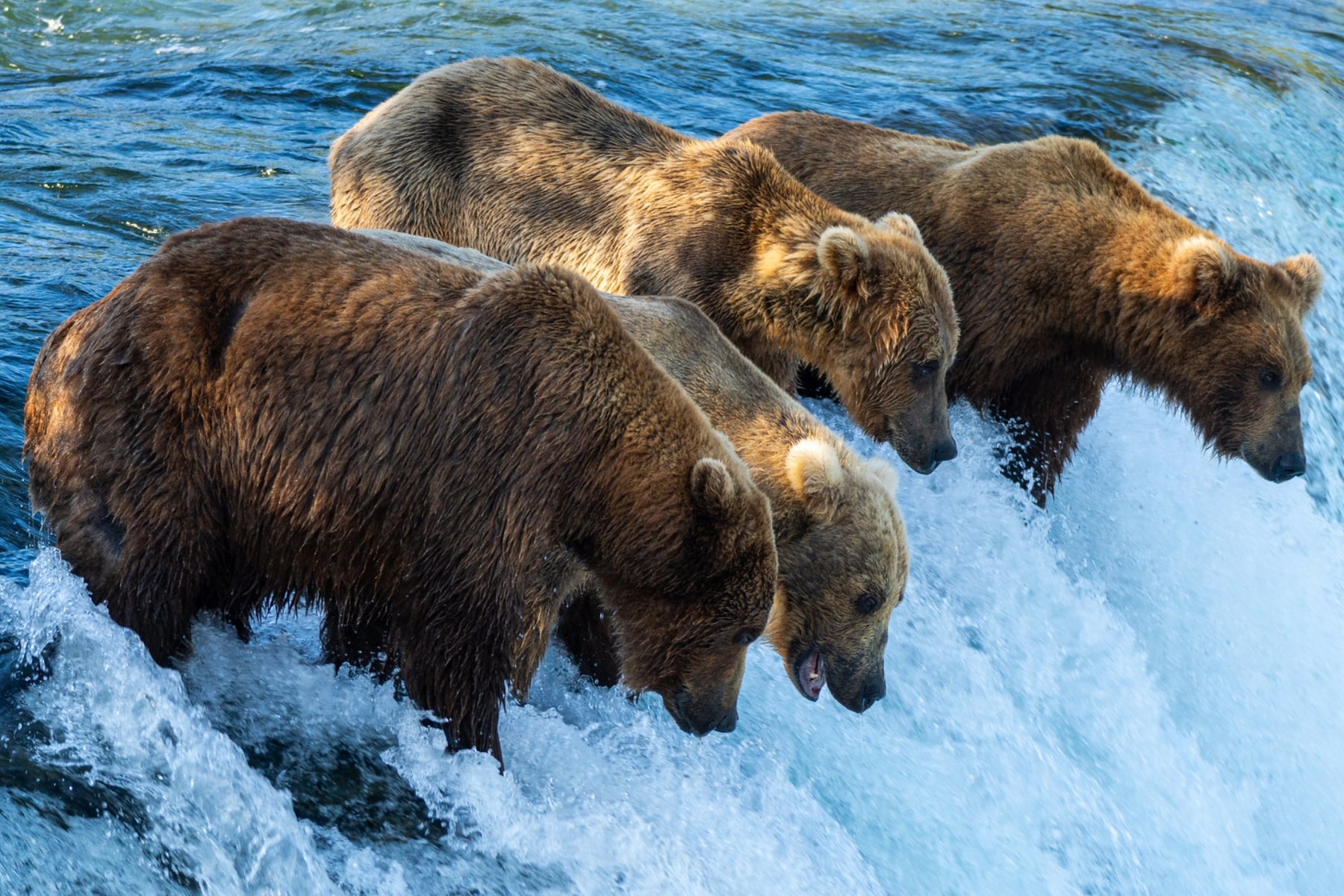
Article Overview: Fat Bear Week
Fat Bear Week at Katmai National Park in Alaska might soon outrank pumpkin spice as the signal that fall arrives. So long, “Hot Girl Summer,” and welcome back to eating as many 4,000-calorie salmon as a bear can handle in Katmai National Park & Preserve.
What started as Fat Bear Tuesday in 2014 and became so popular park rangers could “bearly” keep up. Millions of people get to experience Katmai National Park, one of the least-visited in the country.
Additionally, Fat Bear Week gets us up close with an animal we are repeatedly told to stay away from in real life. Not only do we get to see bears in action, but we also get to see some of the biggest brown bears known to man. And we get to watch them get bigger.
We have the skinny on Fat Bear Week, including so many bear photos, how feasting leads to baby bears (+cub photos) and behind-the-scenes of this salmon feast.

Table of Contents: Fat Bear Week 2023


What is Fat Bear Week?
Fat Bear Week tracks the progression of bears in Katmai National Park after an all-too-short summer of feasting and fattening for hibernation. Concurrently, cameras placed around the popular feeding spot of Brooks Falls and the Brooks River let us see the bears bulking up.
Katmai National Park rangers and the team at Explore.org work together to feed the human appetite for the Fat Bear Week information. In addition to live cameras, online chatrooms and discussions, and social media engagement, a single-elimination tournament each October tabulates the popular vote for the Fat Bear Week winner.
Fat Bear Week usually runs the first or second week in October. You can follow along with the progression of Fat Bear Week on the dedicated website, but we wanted to share some fascinating facts and stories of bears in Katmai National Park to supplement your interest.
Teacher’s Pet: Get your classroom involved in Fat Bear Week with these resources.
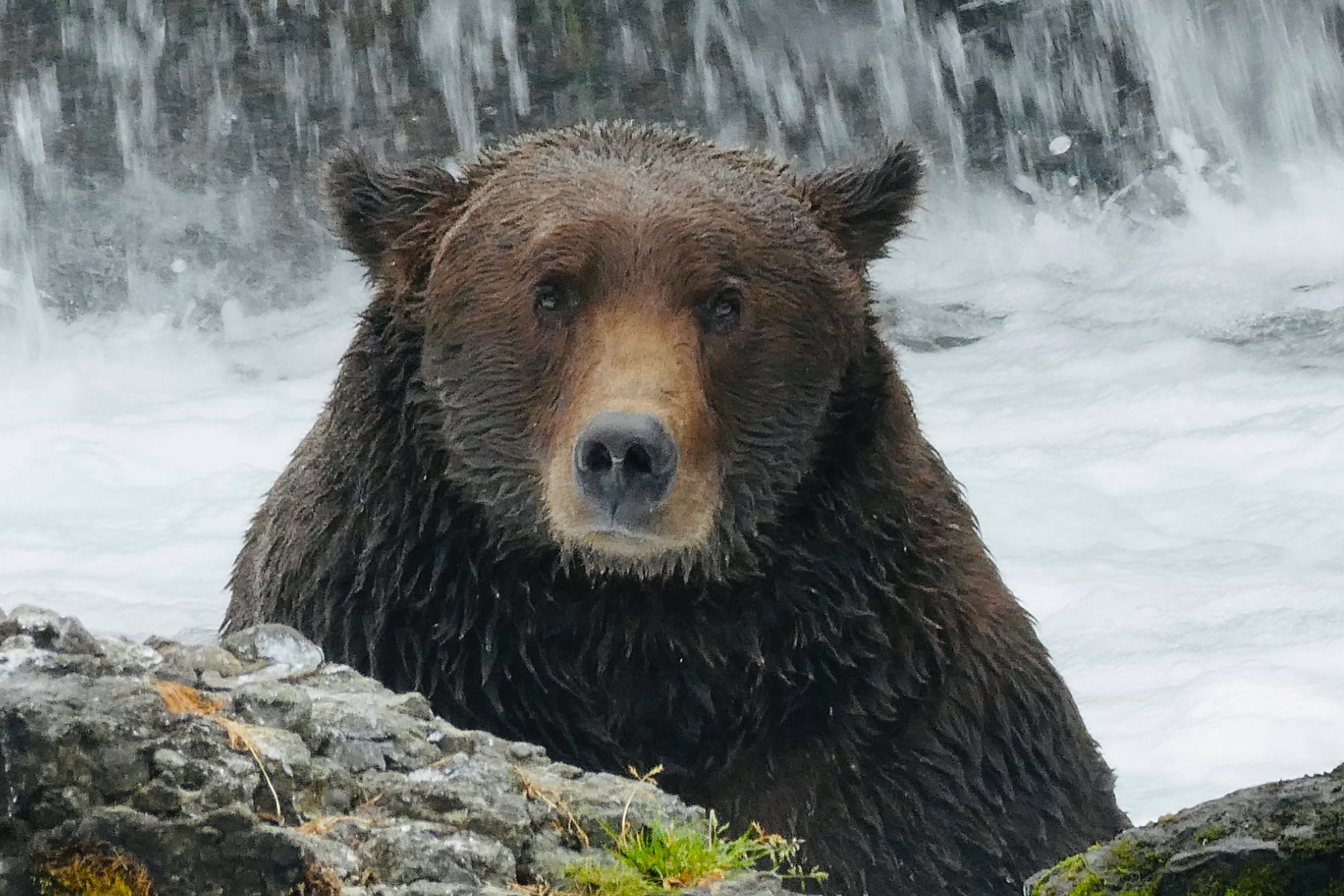
The Bears of Fat Bear Week
The bears of Katmai National Park shouldn’t just be known for their fat assets. Their lifestyles have long been studied by park rangers, long before social media made them stars.
In this park, only brown bears roam (aside from that one lonely black bear seen several years ago). A brown bear is a larger version of a Grizzly bear. Brown bears roam the coastal waters of Alaska and are also referred to as Katmai bears.
FAT BEAR FACT: Katmai bears can weigh up to 1,000+ pounds at their heaviest. At the same time, no known bear in Yellowstone comes close – the heaviest weight on record is 900 pounds, with an average of 300-700 pounds.
Types of Bears in North America
Most of us have heard the saying, “If it’s black, fight back. If it’s brown, lie down. If it’s white, goodnight,” to refer to when confronted by a black, brown, or polar bear. How much beyond that do we really know about bears, and where do Fat Bear Week bears fall in this hierarchy?
American Black Bear
- Average Height: 2.5 to 3 feet (0.76 to 0.91 meters)
- Average Weight: 200 to 600 pounds (91 to 272 kilograms)
- Location: Throughout North America, from Canada to Mexico.
The American Black Bear is the smallest of the bear bunch. You can find them plentiful in places like the Appalachian Mountains, Great Smoky Mountains, and Western U.S. wilderness. Not all black bears are black. In fact, they range from white to gray to brown to black. Some are even cinnamon-colored.






Grizzly Bear
Average Height: 4 to 7 feet (1.2 to 2.1 meters)
Average Weight: 300 to 1,200 pounds (136 to 544 kilograms)
Location: Native to North America, including western and northern regions like Yellowstone National Park and Glacier National Park.
Grizzly bears stand taller than black bears, but that’s not where the differences end. Look for the distinct shoulder hump and curved nose instead of the flat nose bridge of a black bear.


Brown Bear/Katmai Bear
Average Height: 7 to 10 feet (2.1 to 3 meters)
Average Weight: 800 to 1,400 pounds (363 to 635 kilograms)
Location: Particularly found in Alaska, including places like Katmai National Park and Preserve.
As mentioned earlier, these bears share many characteristics of grizzly bears, but their location and size distinguish them. These make up the Fat Bear Week bears.


Polar Bear
Average Height: 8 to 10 feet (2.4 to 3 meters)
Average Weight: 900 to 1,600 pounds (408 to 726 kilograms)
Location: Found in Arctic regions, such as Alaska and northern Canada, primarily on sea ice in the Arctic Ocean.
As big as the Fat Bear Week bears get, they still pale in size compared to polar bears. These beasts have black skin to absorb heat and white fur to blend in with their surroundings.
Where can I see a polar bear?: If you’re hoping to see a polar bear at Katmai National Park, you’re out of luck. These bears are only found at Bering Land Bridge National Preserve and Cape Krusenstern National Monument.
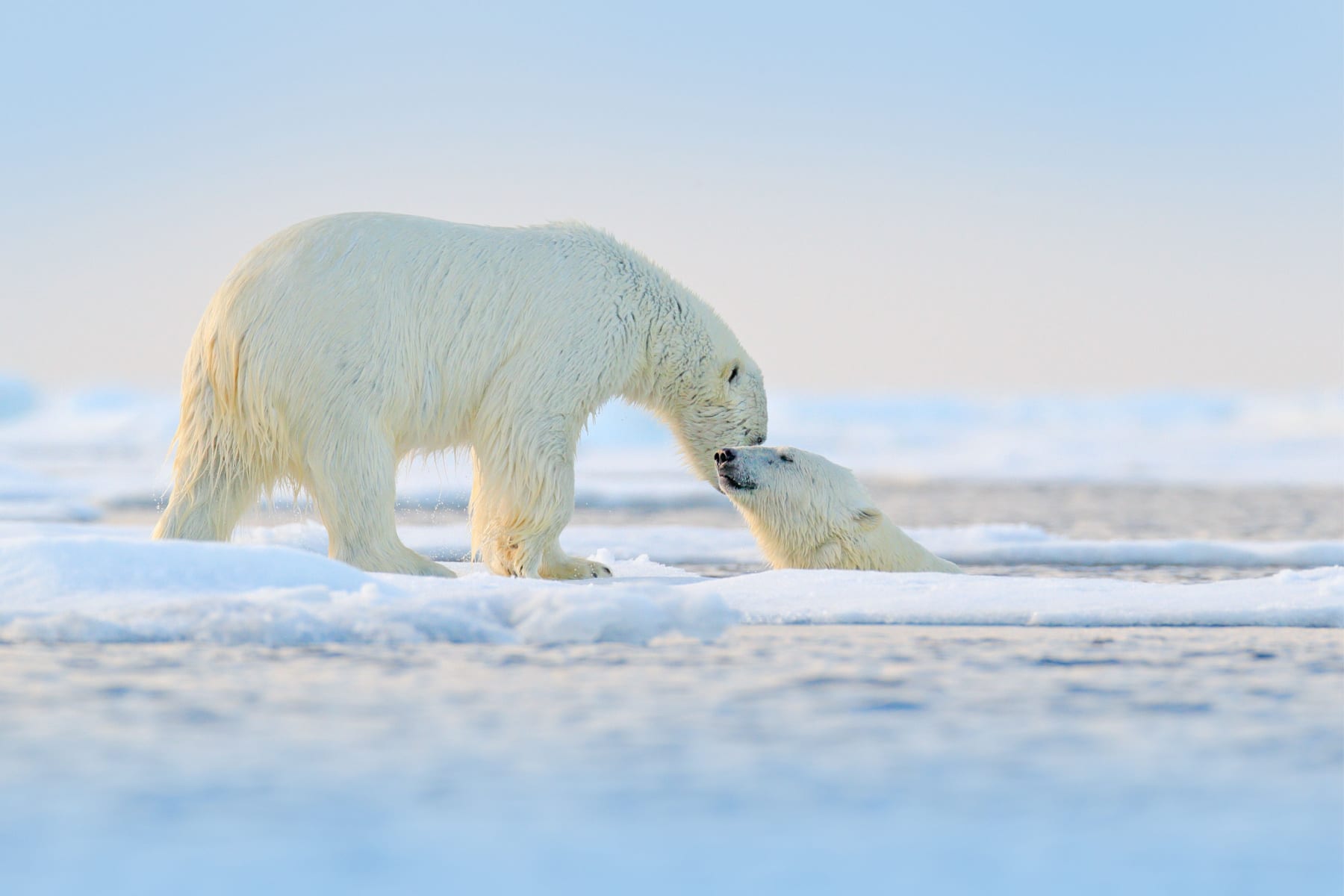
How Americans Became Obsessed with Bears
President Theodore Roosevelt played a pivotal role in the creation and expansion of national parks and the conservation of natural resources during his time in office from 1901 to 1909. At the same time, he inadvertently inspired what would become one of the favorite toys for children around the world.
An avid outdoorsman, he was often referred to as Teddy during his adventures. During a Mississippi bear hunting trip in 1902, Teddy tried mightily to hunt a bear. His attendants tried to help by tying a bear to a tree, making it an easy target.
However, when President Roosevelt saw the helpless and wounded bear, he refused to shoot it, deeming it unsportsmanlike and inhumane.
This act of compassion and sportsmanship by the president was widely reported and became an iconic cartoon in the Washington Post.
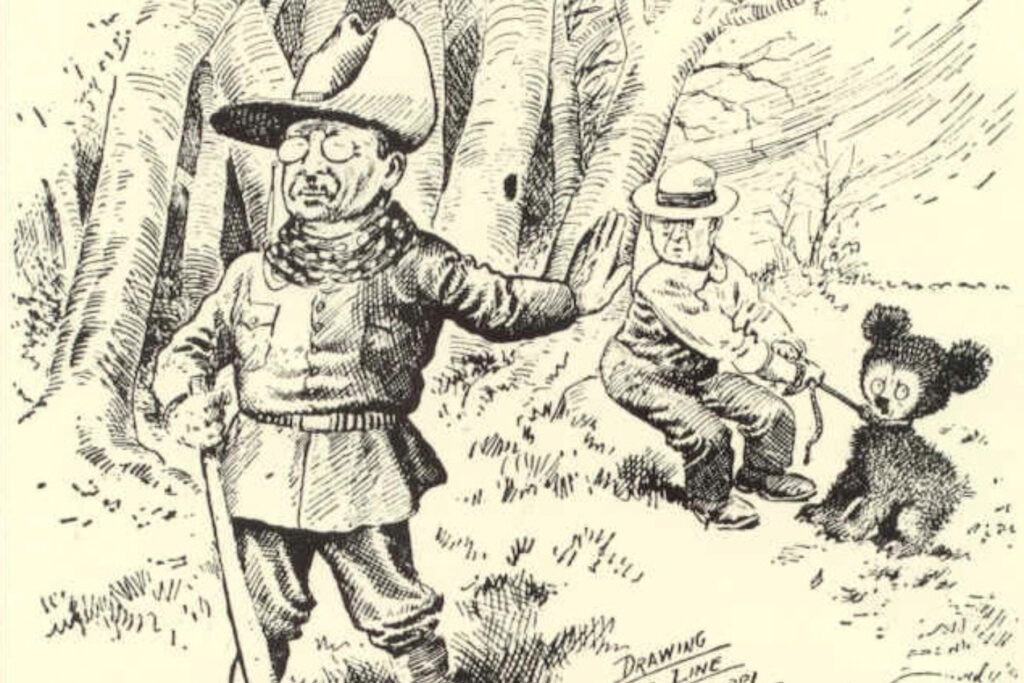
A Brooklyn-based toy store owner named Morris Michtom and his wife, Rose, decided to create a stuffed toy bear and named it “Teddy’s Bear” in honor of President Roosevelt. Thus began an American love affair with the adorable Teddy Bears, an industry valued at $6.4 billion in 2022.
Did You Know? Bears are also referred to as ursines, which is the Latin word for… bear.
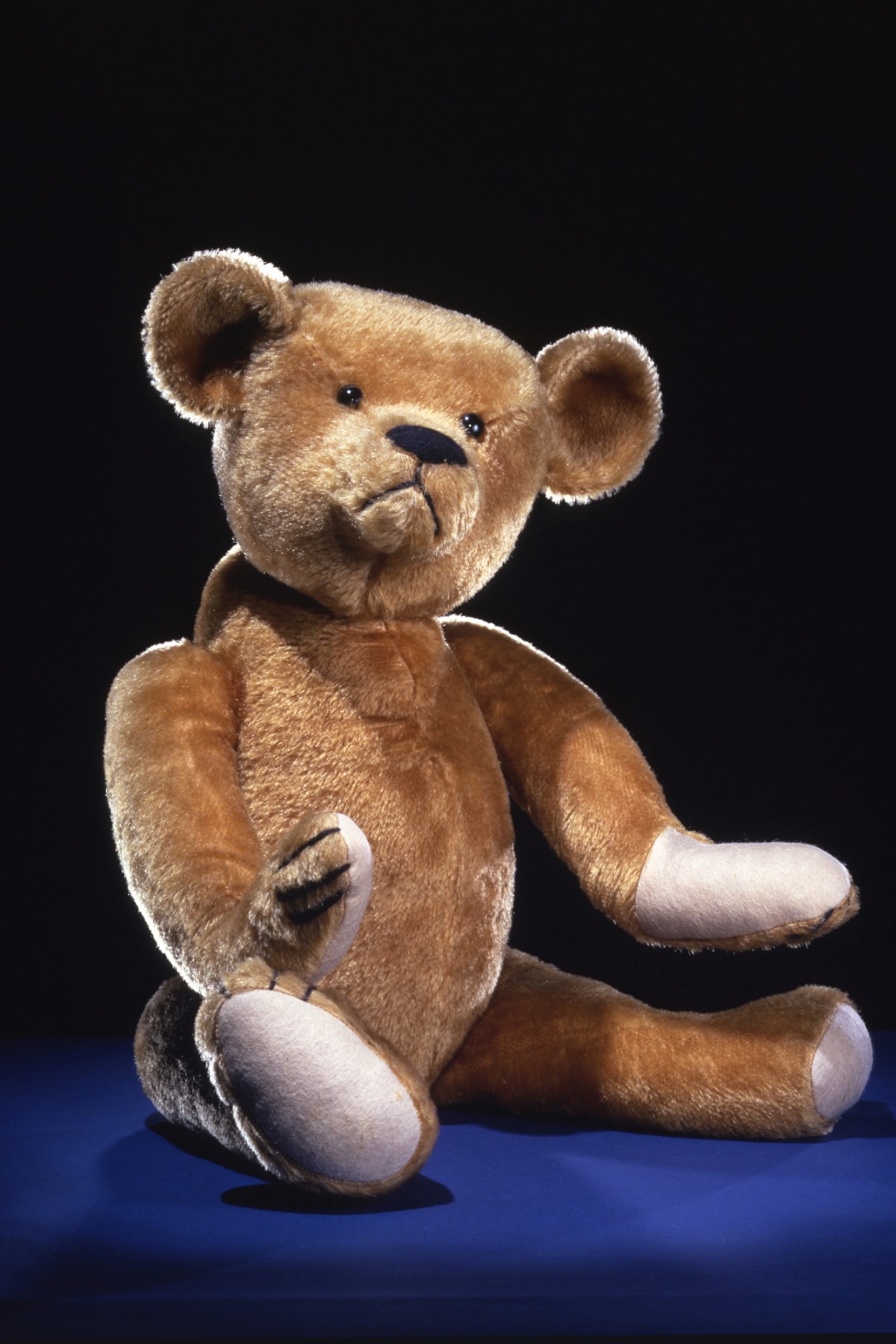
Fat Bear Week Bear Names
When reviewing the bracket for Fat Bear Week, you’ll see there are numbers next to each bear. That’s a park-assigned number for tracking purposes. A number helps keep the animals wild and avoids anthropomorphizing them. On the other hand, several have earned nicknames, like the popular Otis (for his O-shaped ears) and Bear Force One (Bear #747).
Identifying Bears
It’s important to note that Katmai bears aren’t tagged or collared. By the way, that’s a decision the park rangers made to avoid any human interaction with them. So how do they know who each bear is between skinny and far or cub and adult?
- Scars: One of the top ways to know a bear’s identity comes through certain scars. For example, 32 (“Churnk”) has a scar on his right eye.
- Fur Color/Shed Pattern: No matter how different bear personalities can be, each has its own fur color and shedding pattern.
- Body Features: Like humans, bears each have curves and signature features. Examples include 504 with a goatee, 477 with a droopy lower lip, and 273 with close-set eyes.
- Body Size: Males are larger than females, to begin with. How do they determine the sex? First, spotting the genitalia. Second, observe urinating patterns. Males urinate straight down, while females urinate behind their legs. Thirdly, if a bunch of cubs are following a bear, that’s a female. Bear dads don’t get involved with the cubs.
- Personality: Bears have specific behaviors and habits. For example, one might be bossy while another is a gentle giant. Some have preferred fishing spots year after year.
TRIGGER WARNING: Cubs aren’t given names by Katmai National Park researchers due to the 50% mortality rate before adulthood. As the National Park Service bear brochure states, “The chances of that cub surviving to adulthood are low, so we set ourselves up for heartbreak by becoming attached to them.” Even the half that does survive will grow and change so much over the years that accurate tracking isn’t possible.
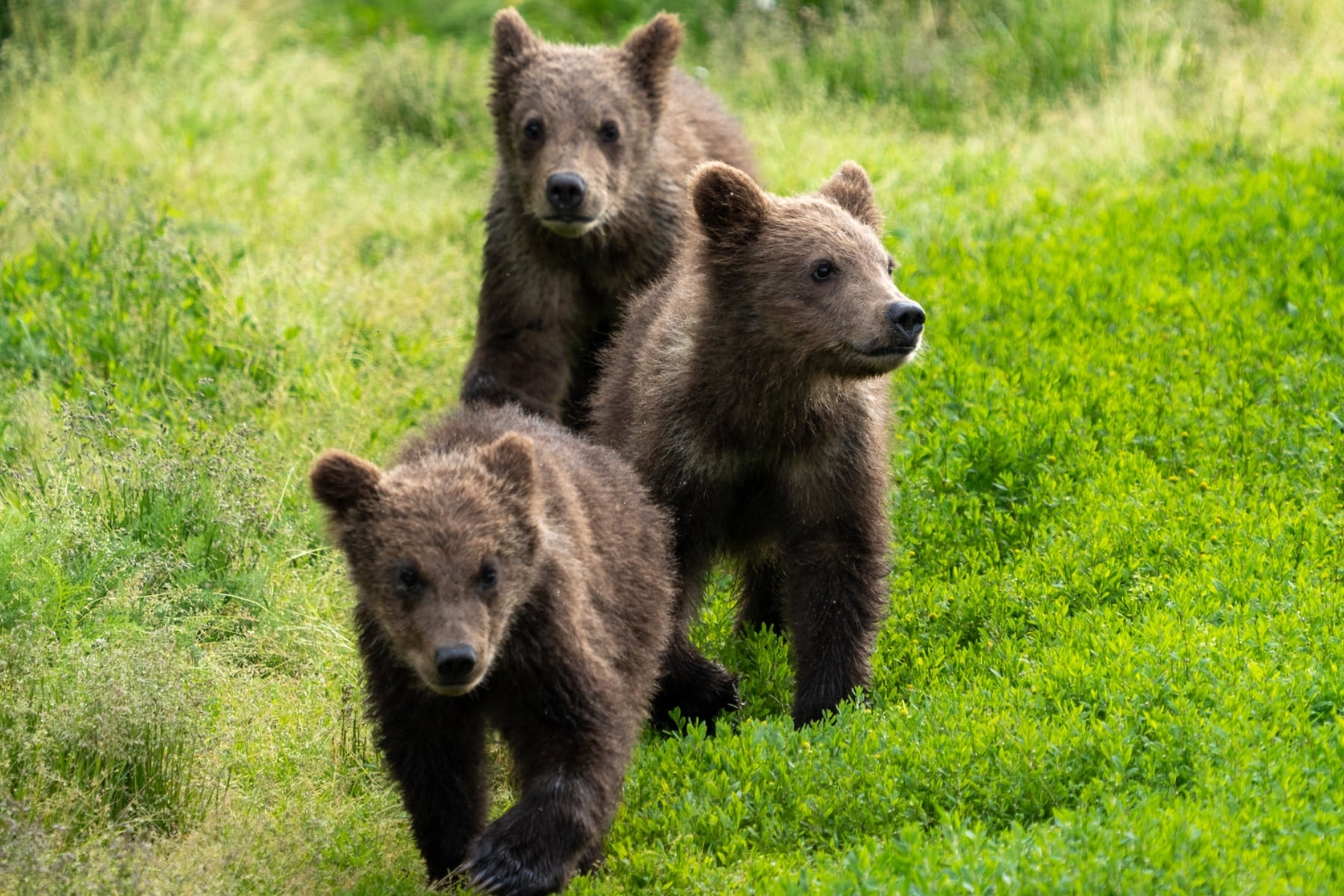
Everything to Know about Fat Bear Life
No sooner do the bears come out of their hibernation than they start packing on pounds, preparing for the next year. Here’s a look at the life cycle of a Katmai bear.
Waking from Hibernation
Season: Late Winter/Early Spring
In late winter or early spring, Katmai bears emerge from their winter hibernation dens. Upon waking, bears are in a state of lethargy and are relatively weak, having relied on stored fat reserves for sustenance during hibernation.
They initially stay close to their dens and feed on available vegetation and carcasses of animals that died during the winter.
BEAR NOTE: Since the bears aren’t tagged, and rangers don’t interact with daily life, there’s no way to track where each bear hibernates. It’s a waiting game to see when they’ll reappear in the spring.
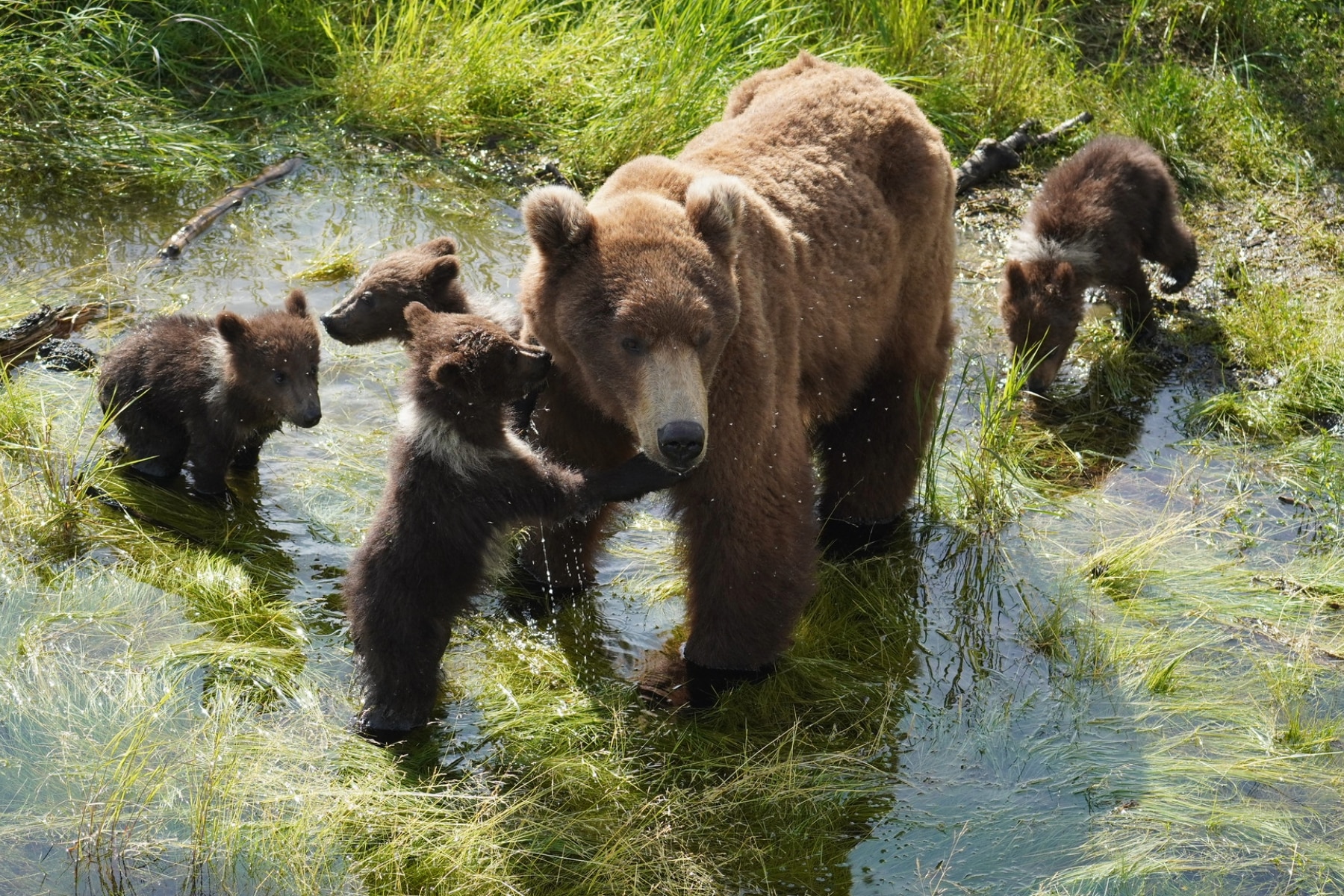
Spring Feeding
Season: Late Spring
As spring progresses, vegetation becomes more abundant. Bears focus on foraging for fresh plants, roots, and grasses to replenish their energy reserves. This is also a time when bears may engage in social interactions, including dominance displays and mating behaviors.
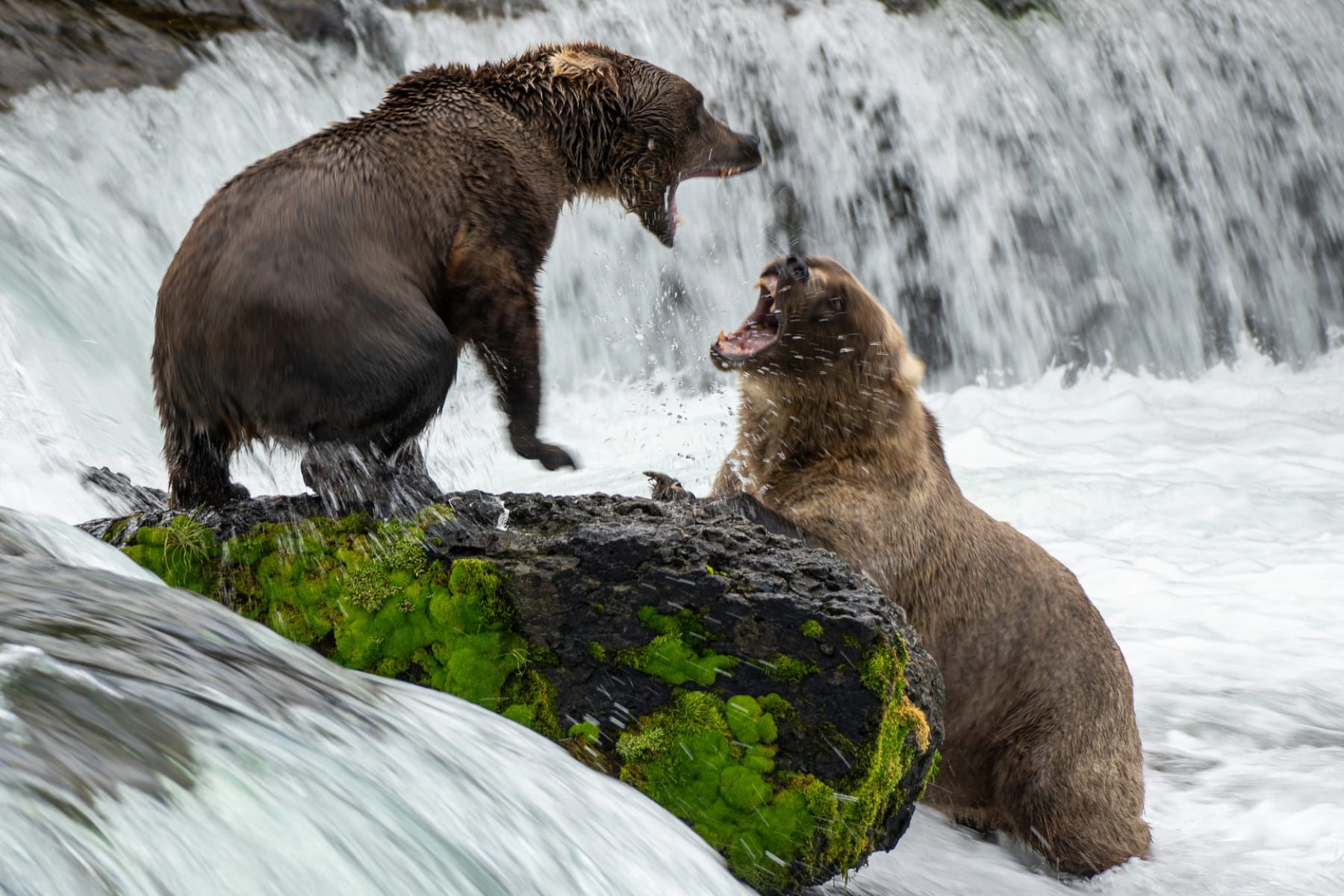
Summer Feeding
Season: Summer
Throughout the summer, bears continue to forage extensively to accumulate fat stores for the upcoming hibernation. They feed on a diverse diet, including berries, fish (particularly salmon in regions like Katmai), and small mammals.
This starts their hyperphagia, where their bodies prepare for hibernation, and they’ll need fat stores for up to six months before they can survive the den.
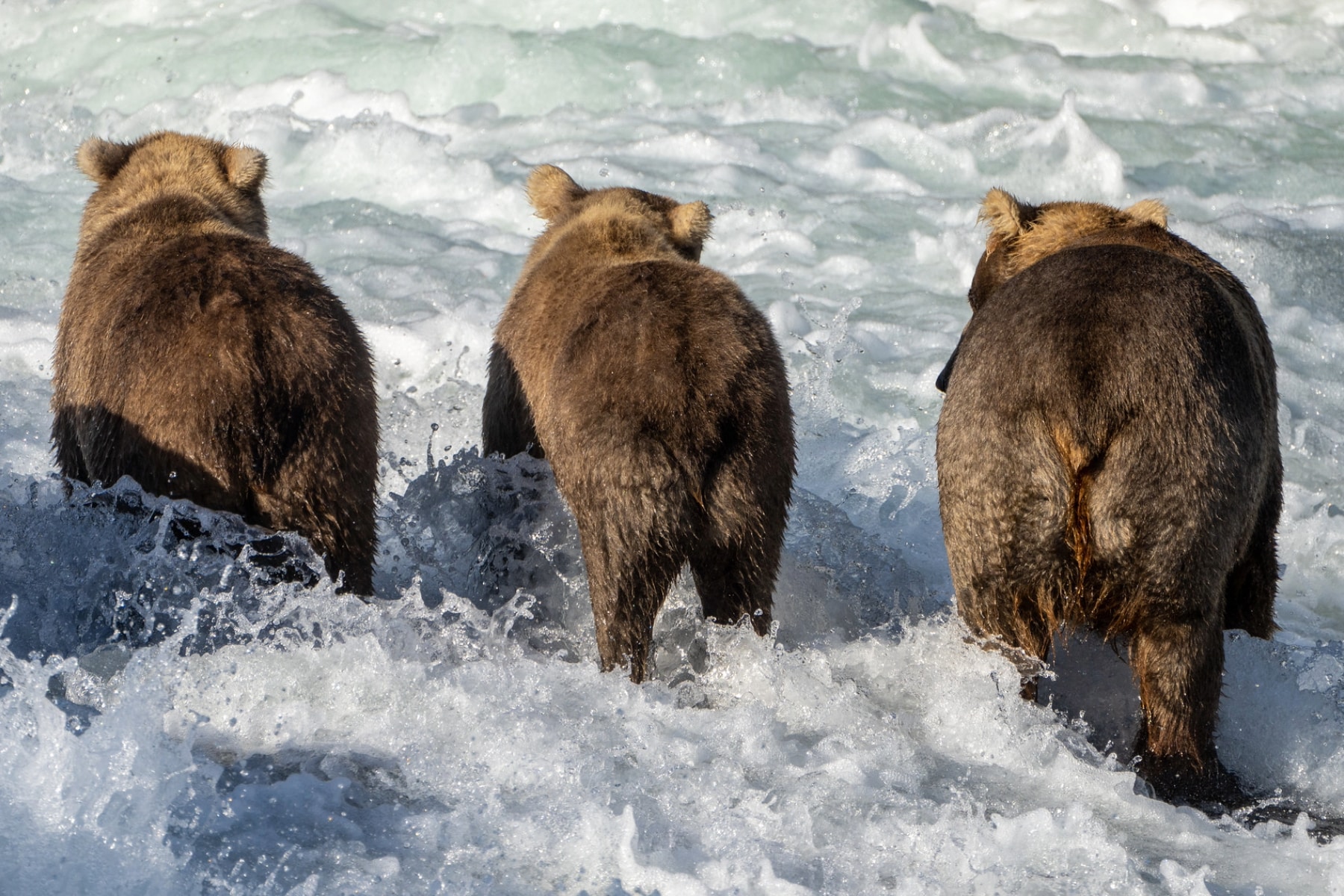
Feasting
Season: Early Fall
Bears continue to feed intensively during the late summer and fall, especially in preparation for hibernation.
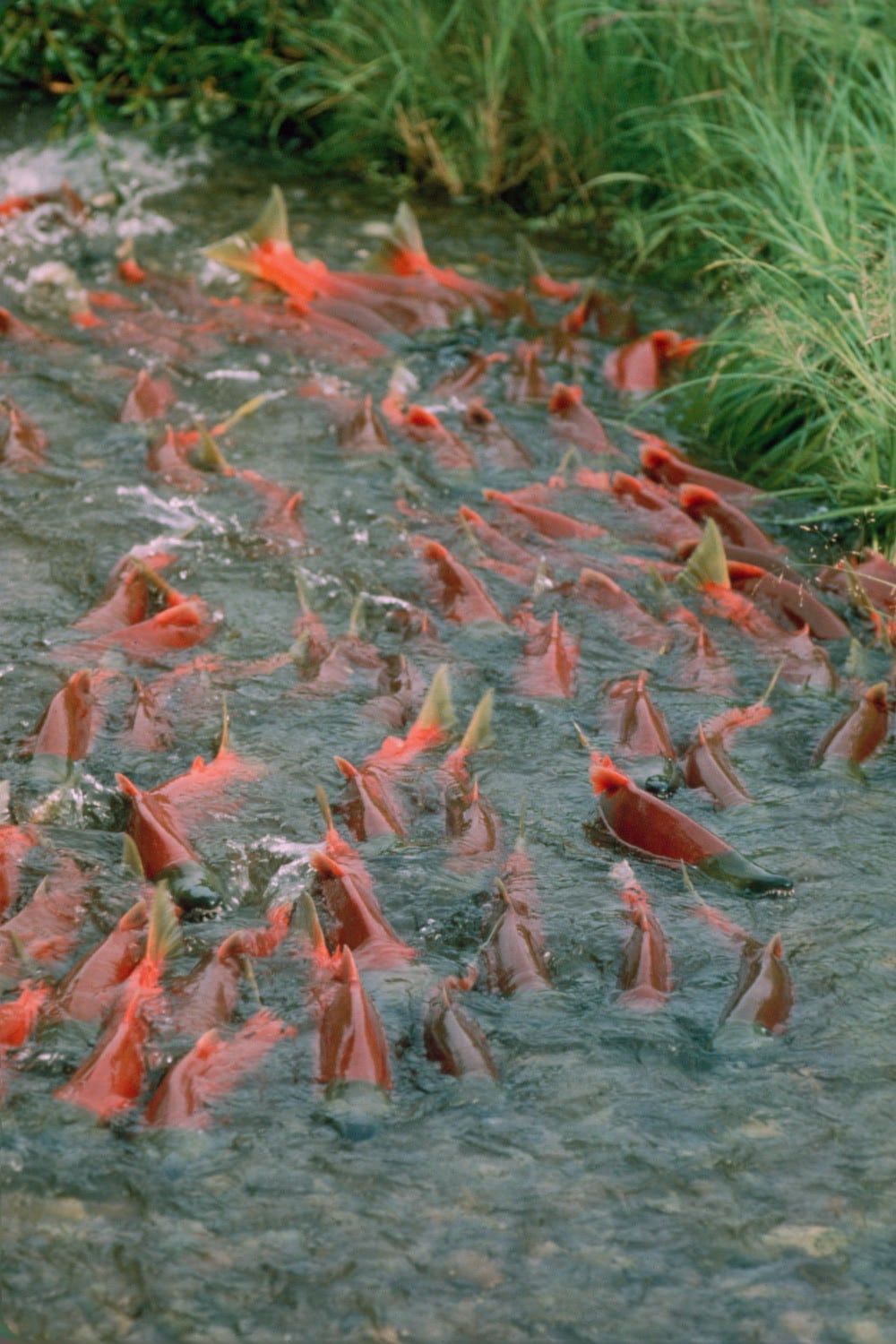
Salmon runs in rivers and streams are a significant food source for bears in regions like Katmai. Salmon runs begin in June and continue off and on through September.
Brooks Falls is such a hot spot because the salmon have to “leap” over the falls to continue their journey. Up to 400,000 in a year might arrive at the falls.
Bears instinctively know how to eat the fattest parts of the salmon and leave the rest to rot or be scooped up by a less hearty bear waiting lower on the river.
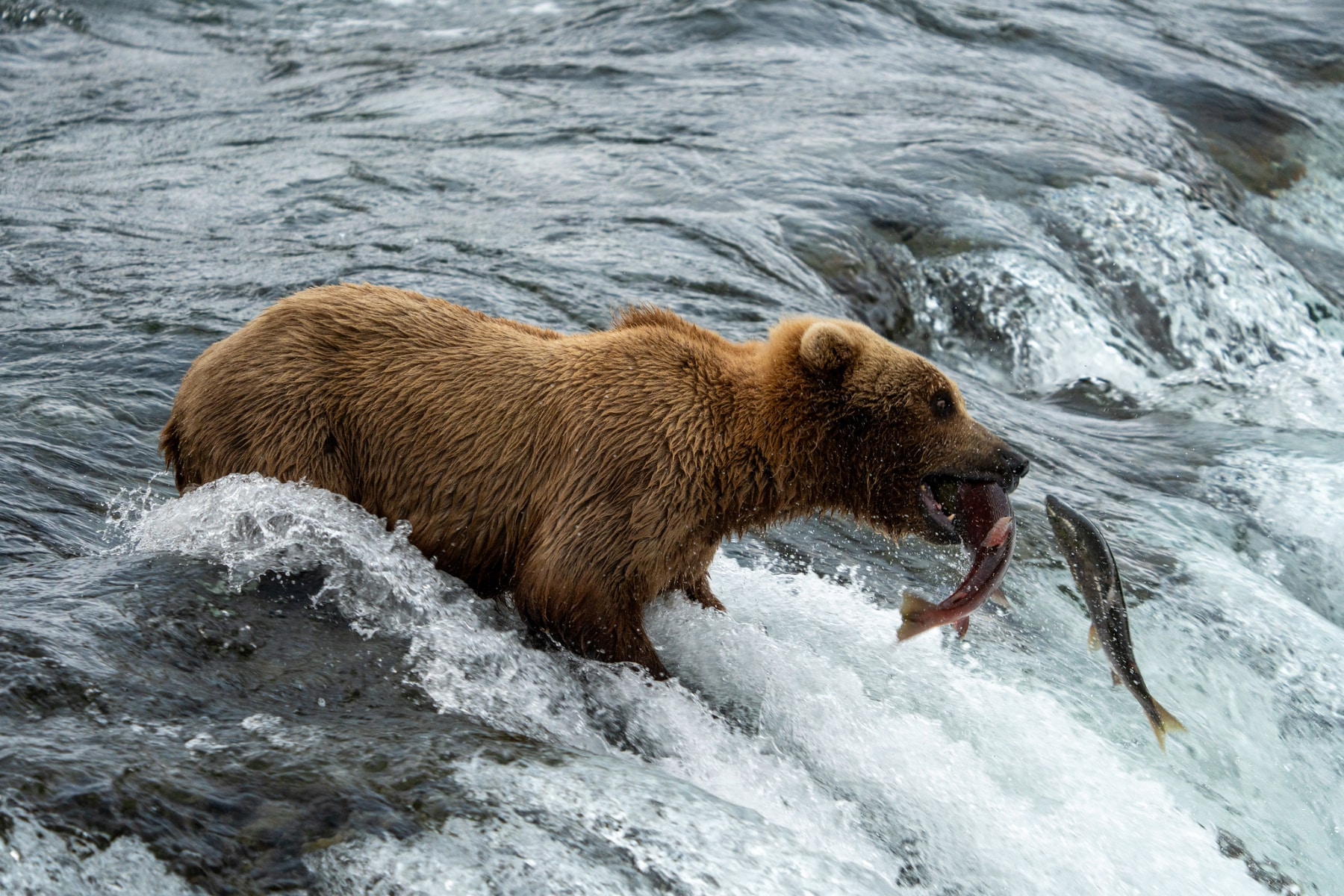
Preparing for Hibernation
Season: Late Fall
As winter approaches, Katmai bears shift their focus towards consuming high-calorie foods to build fat reserves. They become increasingly solitary and less active, preparing to enter hibernation. This is when they start building their den.
Hyperphagia runs until the food sources start to run out, and then their bodies shift to an amazing down cycle of preservation and survival.
Hibernation
Season: Winter
Katmai bears, like other grizzlies, enter hibernation in winter to conserve energy when food is scarce. During hibernation, their metabolic rate and body temperature drop, and they rely on stored fat for nourishment. Bears hibernate solo unless it’s a female who births cubs in the den.
In fact, bears don’t even urinate or defecate in the den. Their body turns the urine into proteins that allow their muscles and bones to stay strong, even with months of resting.
Did You Know: We say bears “hibernate,” but it’s really more of a torpor state. That means the bears do fall into a deep sleep, but they aren’t immobile for those six months. They’ll move around from time to time and be ready to attack if a predator approaches. (Another reason rangers don’t try to tag or collar them.) Those female bears can be rather busy in the den, too. Keep reading…

Mating Habits of Brown Bears
Beyond their cuteness, bears come with incredible instincts and survival abilities. The mating season begins in the summer, with June serving as the month with the most mating. However, it’s not that simple. To start with, female bears play what humans like to call “hard to get” as they determine the quality of the potential mate. Then, things get interesting.
“All bears are promiscuous and are open to mating with mutiple partners. So, it’s absolutely possible for a single litter to have multiple fathers.”
Kim Grossman, Katmai National park
Since female bears only gestate for three months, that seems like pretty bad timing for a bear trying to bulk up to survive winter. Then again, their intricate reproductive system knows it’s not time to implant those eggs. A would-be momma bear needs to fatten up for her own survival and for her cubs to have a chance of making it through the den life.
Surprisingly, the sow’s eggs won’t implant if the host bear doesn’t have enough fat. That is usually a minimum of 20% extra fat. Bear cubs are about a pound at birth, and feeding a smaller creature uses fewer calories, allowing for better chances of survival. In addition, male suitors won’t go after skinny sows.
During one hibernation, a sow could give birth to anywhere from one to four cubs, with two to three being the average.
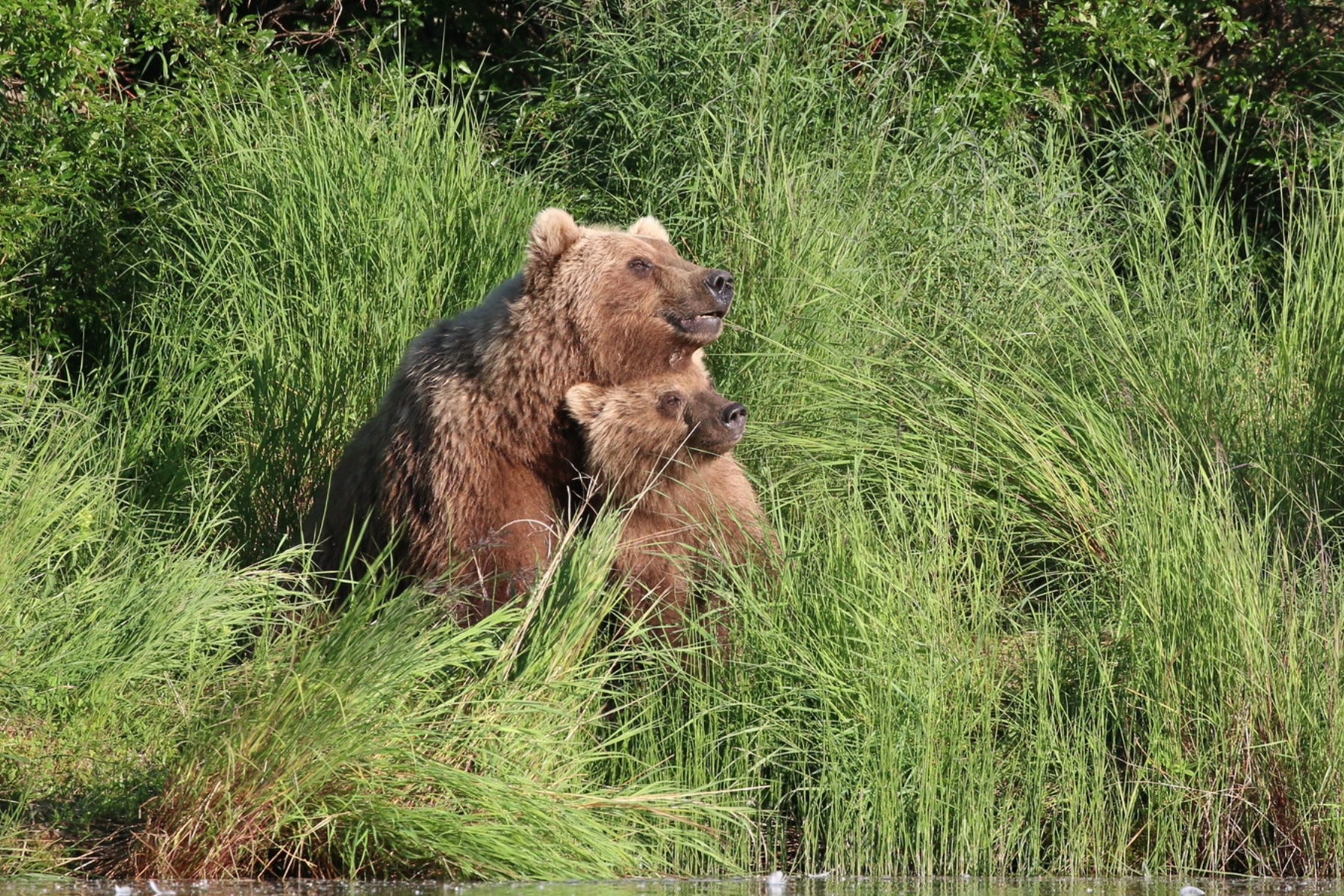
How Katmai Bears Fish
Part of a bear’s personality displays in how it chooses to get the fat-filled fish. From creativity to patience to dominance, let’s explore the styles.
- Just Stand There: You must be a big beast and alpha bear to win a spot on top of the falls. Seeing that these bears get the prime spot, they just sit and wait for fish to jump in their mouth.
- Have a Seat: Whenever you see a bear just sitting at the base of the falls like it’s a jacuzzi, what they are really doing is waiting for fish to bump into them. Then, they snatch the salmon as a snack.
- Whack-A-Salmon: These bears burn a lot of energy trying to whack a salmon with their massive paws. It’s productive when fish are plentiful but exhaustive when the numbers dwindle.
- Snorkeling: Katmai bears have about three minutes of tolerance for having their head underwater. This tactic works to find dead or dying fish at the bottom of the river.
- Diving: Diving can be more a sign of desperation as bears search for dead salmon below. Bears aren’t particularly fond of swimming and burning energy. If you’ve been following Katmai bears for a while, you might remember “Diver,” who loved this technique.
- Stealing: Some bears become bullies during the season and simply take what another bear catches. As a result, if you see a bear run away with a fish, they’ve likely been salmon-mugged before.
- Begging: You can’t guilt a bear, even if you’re a hungry, skinny bear. That doesn’t stop some from trying. When begging doesn’t work, the bears will wait downstream for leftovers to float by.
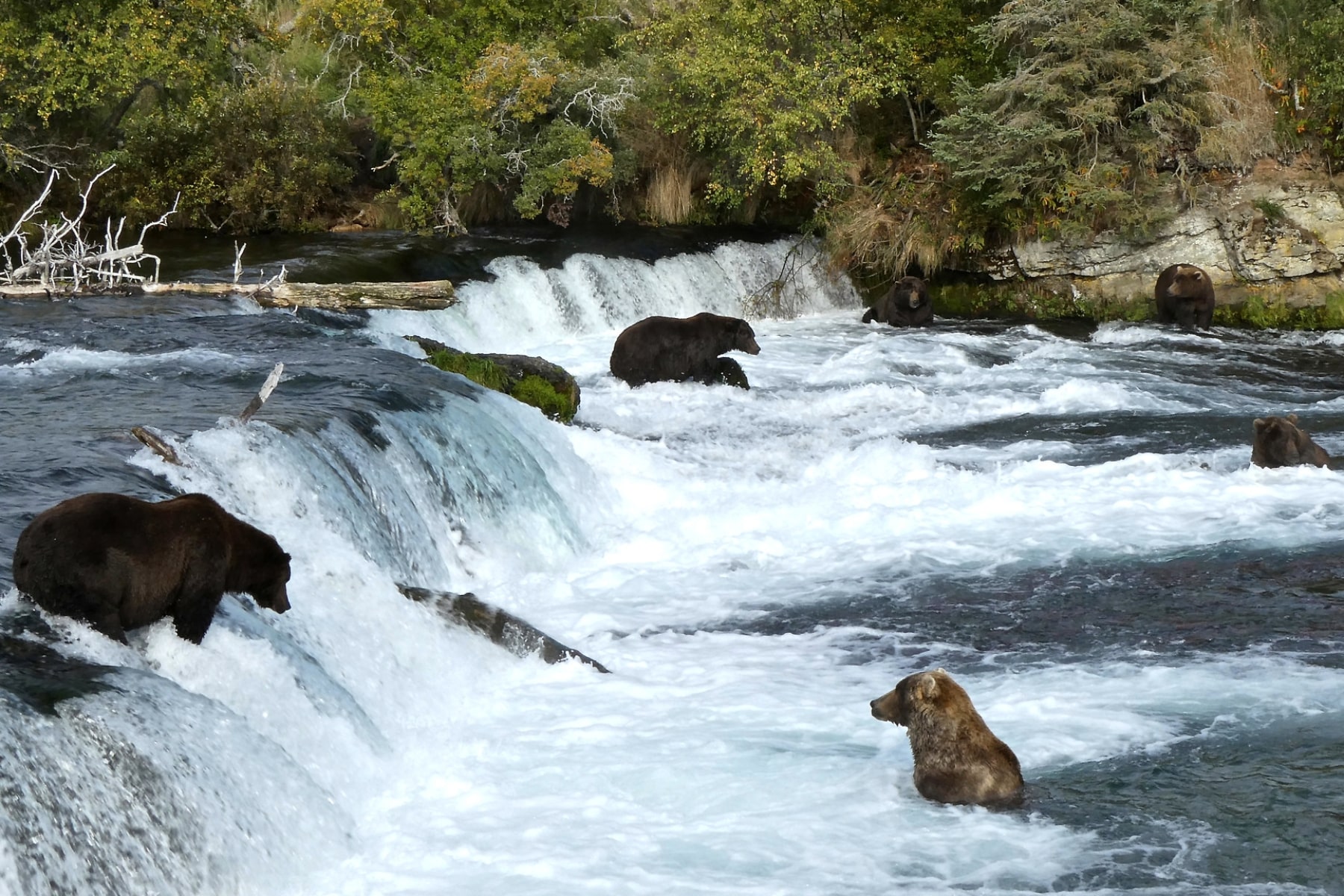
How Rangers Track Bears in Katmai National Park
If all this bear talk has you wishing you could be a bear researcher, here’s what to expect in a day of the life tracking Fat Bear Week bears and beyond at Katmai National Park.
Fat Bear Week Camera Saves a Life
The bulk of bear activity runs through the summer into fall, and the camera on Dumpling Mountain helped save a lost hiker in 2023. A man approached the camera and was speaking, but there was no audio. A sharp-eyed viewer could see the man mouth the words “Help Me.” Rangers were called to rescue the man.
The hiker was lost two miles from a trail and in an area where the fog makes it impossible to look for landmarks or retrace steps.
“Dumpling Mountain is in a remote section of Katmai and this is the first rescue that I’ve heard of in that area.”
Peter Christian, public information officer for Katmai national park
FAQ Fat Bear Week
Fishing is one of the most popular activities at Katmai. Tour companies help plan amazing trips, or experienced anglers might choose to go solo. You do need an Alaska fishing license. Catch-and-release fishing is allowed, and if a bear approaches, it gets first dibs. Fishing must stop, and lines must be cut when a bear is within 50 yards.
No. As part of the “no interaction” rules, bears don’t get weighed. Fat Bear Week is essentially a popularity contest. However, the ongoing interaction with rangers and Explore.org researchers helps you get the “bear” necessities to choose your favorite.
I saw this question online and simply had to address it with a bit of a chuckle. Bears have no idea they are named, internet famous, or competing against each other. Their only competition is survival of the fattest.

Visiting Katmai National Park and Preserve
While the bears are the hot topic at Katmai National Park, you might wonder what else there is to see. How about more than a dozen active volcanoes, for starters?!
Katmai National Park and Preserve sits on a massive piece of land – nearly 4.1 million acres. That’s almost twice the size of Yellowstone National Park, more than three times larger than Grand Canyon National Park, and you could fix six Yosemites in Katmai.
If you think seeing bears on a camera is interesting, you’ll be amazed at the in-person viewing. So why is this park only seeing around 34,000 visitors a year? Location, Location, Location.
Getting to Katmai National Park
You’ll need an adventurous spirit to get to Katmai National Park, which sits nearly 300 miles southwest of Anchorage. The only way to arrive is by plane or boat. Many choose to fly from Anchorage (ANC) to King Salmon (AKN), but the park coordinates with many vendors to offer boat rides and private planes to access the park.
Summer and fall make the best seasons to visit Katmai National Park, especially if you’re worried about the weather.
The Wilderness of Katmai National Park
It doesn’t get wilder than Katmai National Park in terms of wilderness. Few services mixed with brutal weather, active volcanos, and rugged trails make this park intimidating, even for those who make it all the way to King Salmon.
It’s 100% doable to visit the park, but extensive planning is required.
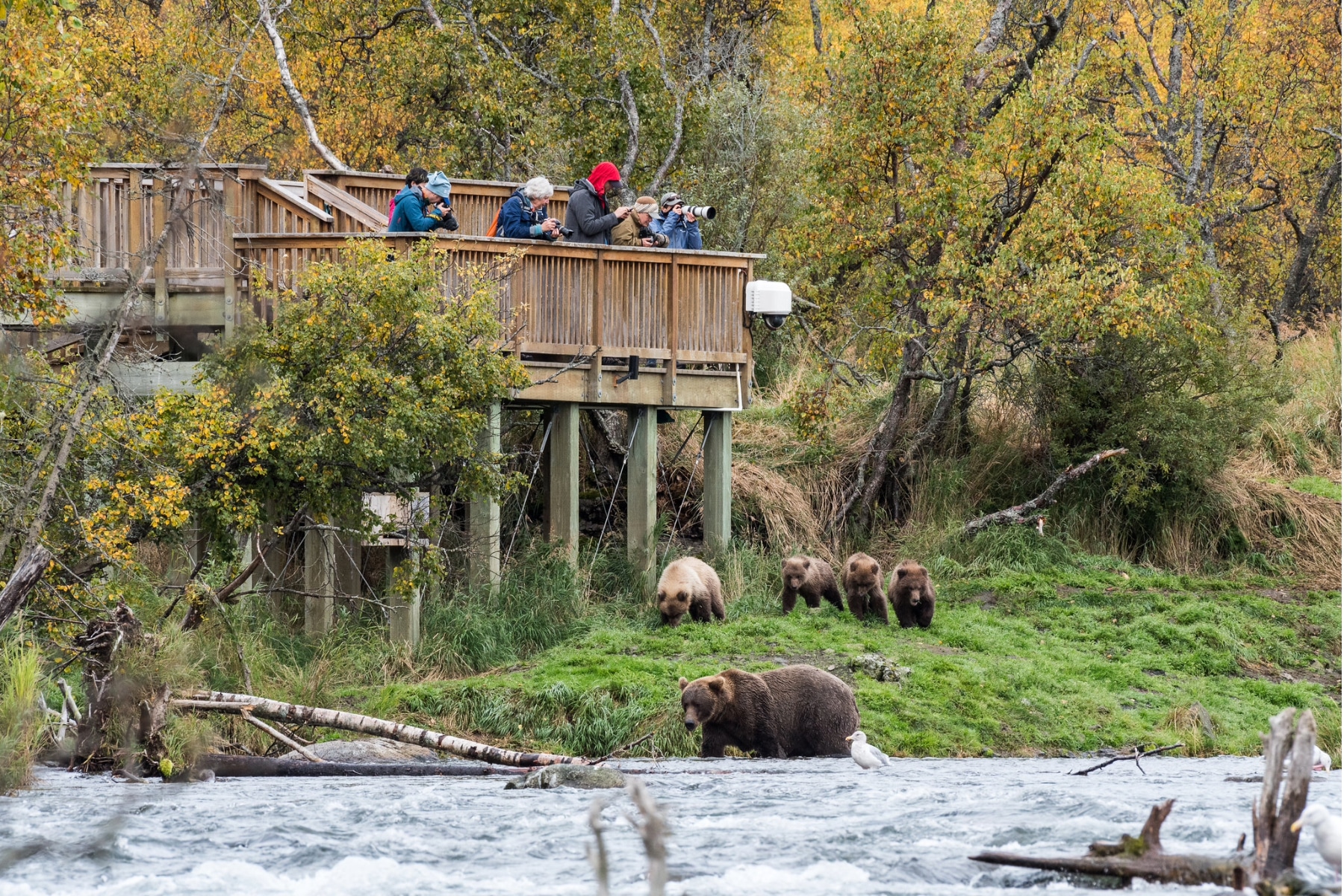
Fat Bear Week Camera at Brooks Falls
Check out these live cameras of Fat Bears around Katmai National Park:
Map Of Fat Bear Week at Katmai National Park
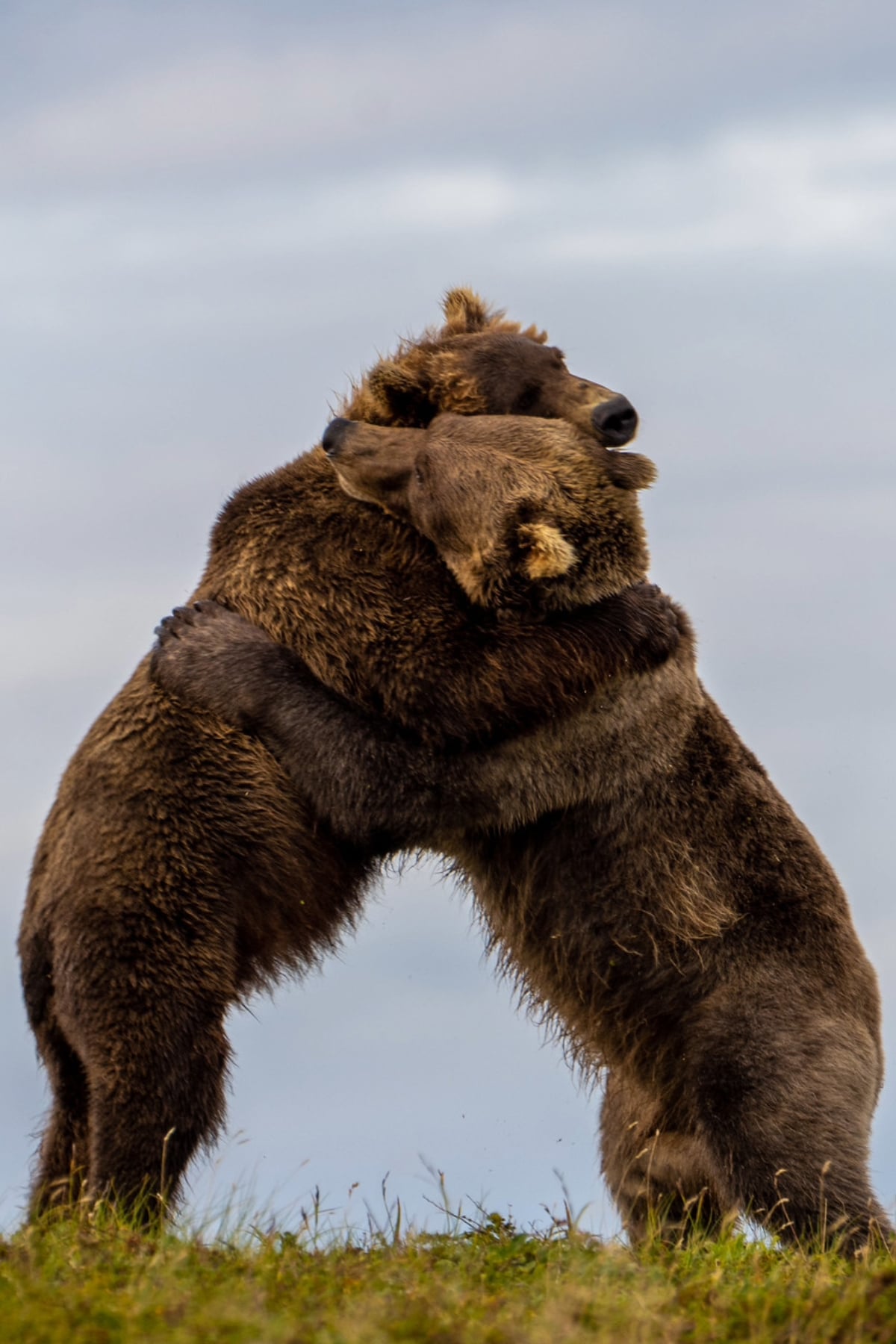
Pin Fat Bear Week
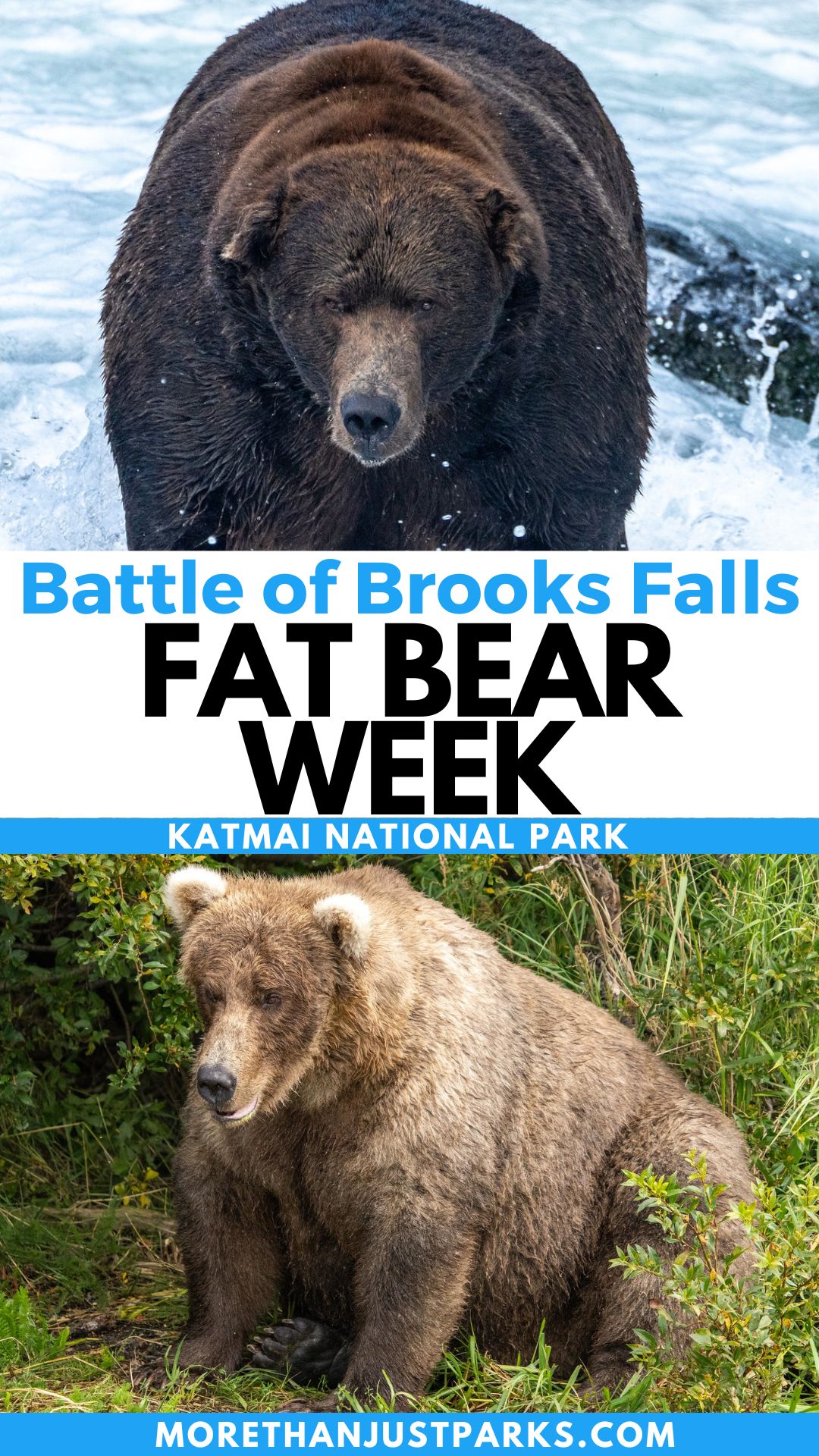
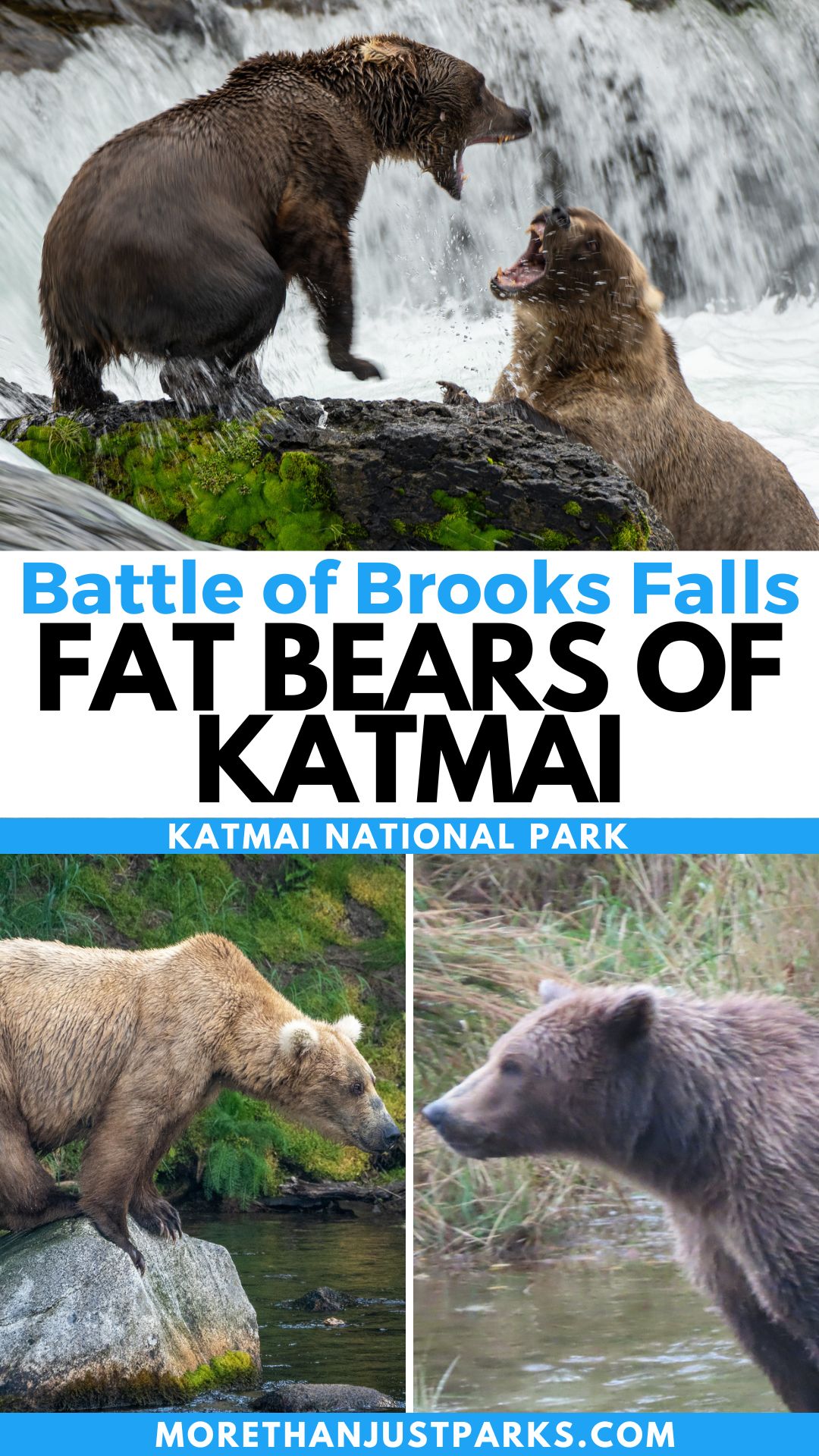
Helpful Related Links
Craving More Katmai?: 11 FASCINATING Facts About Katmai National Park & Preserve
Alaska National Parks: 8 Amazing Alaska National Parks (Tips for Visiting)
Glacier Bay National Park Facts: 11 Amazing Glacier Bay National Park Facts
Denali National Park Facts: 10 Fascinating Facts About Denali National Park
National Parks Ranked: All 63 Best US National Parks Ranked from Best to Worst
List Of Parks: Official List of US National Parks (Alphabetical & by State)
Map Of National Parks: Printable Maps of the National Parks
Best Wildlife Viewing: 10 BEST National Parks for Amazing Wildlife Viewing (Photos + Tips)
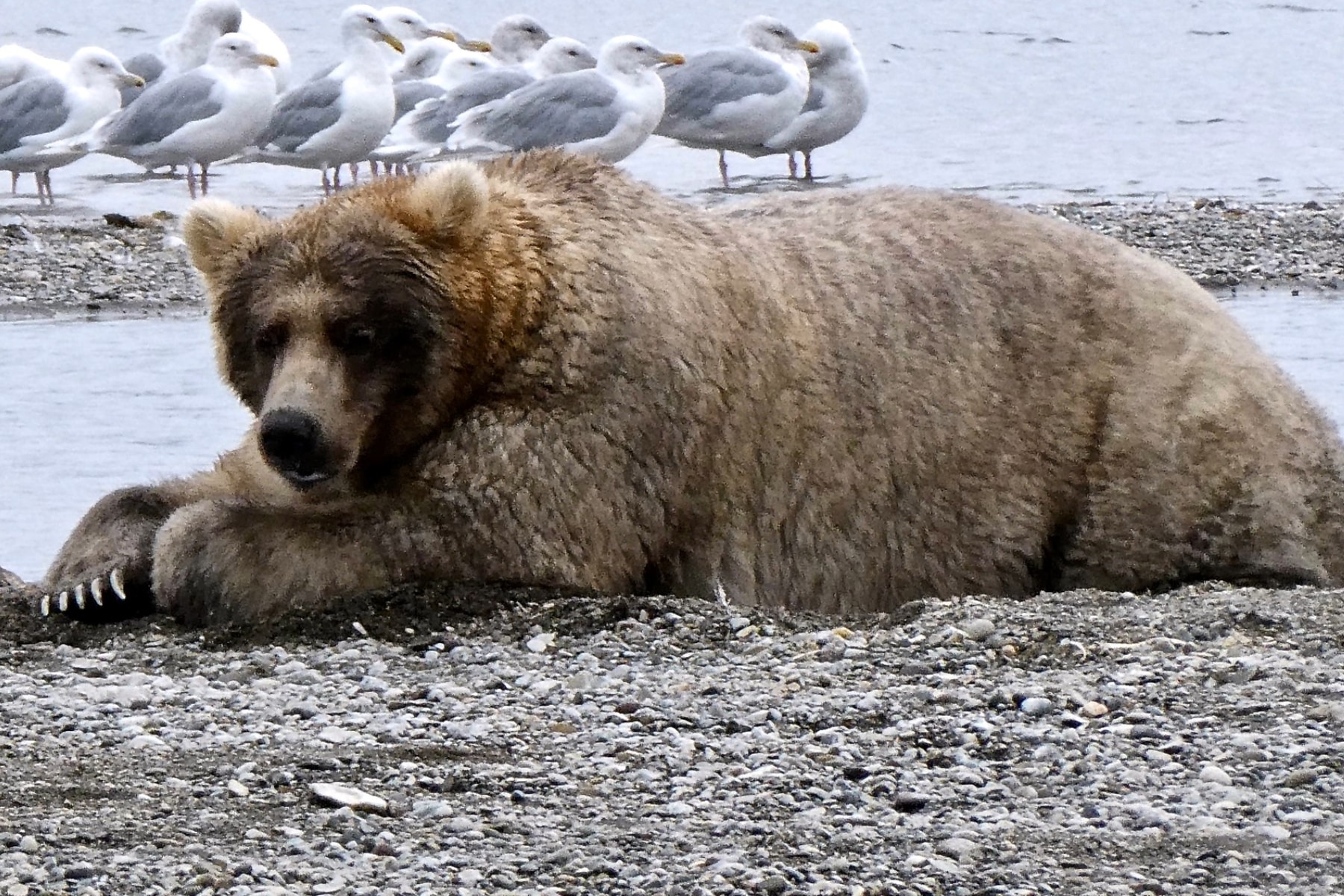
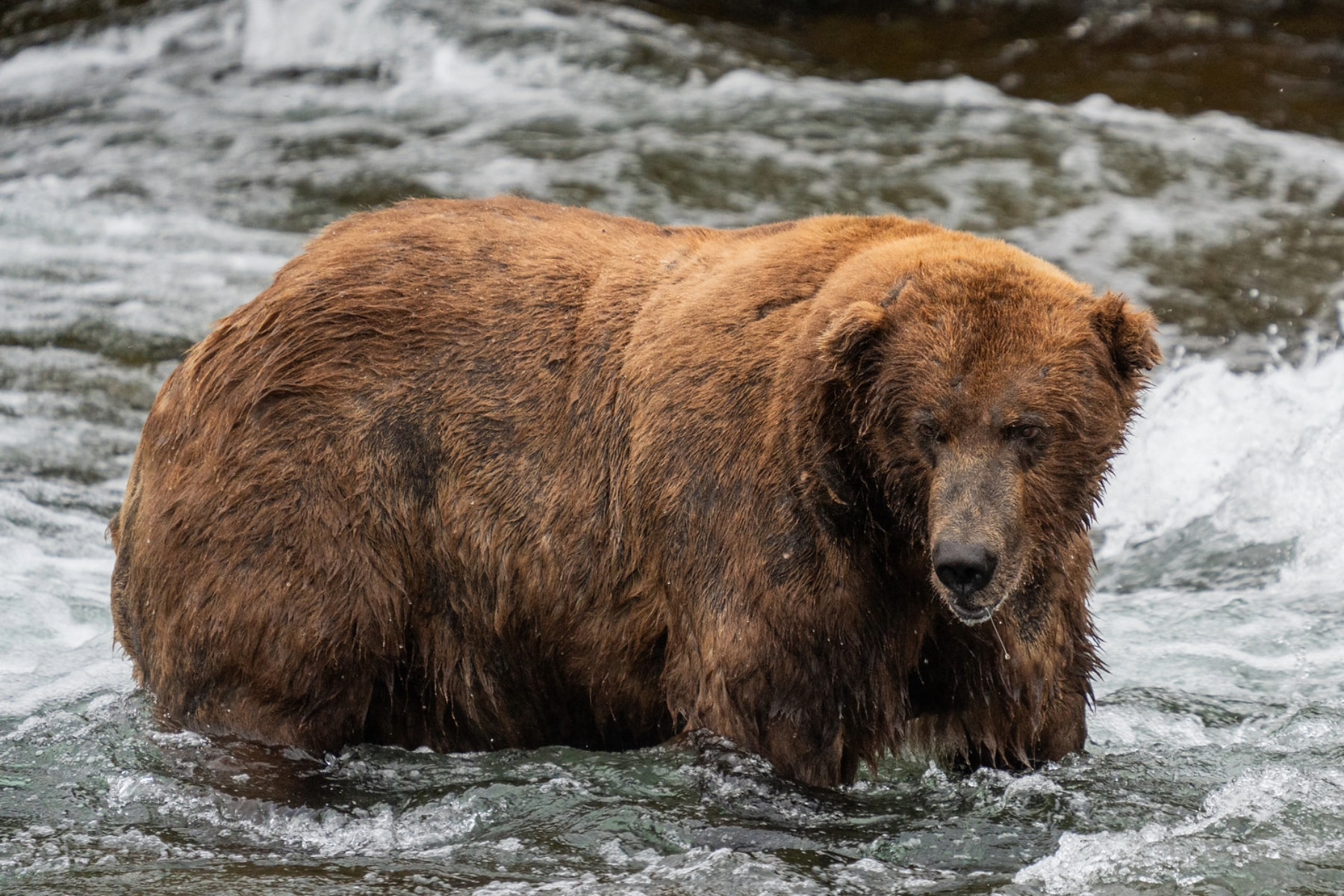
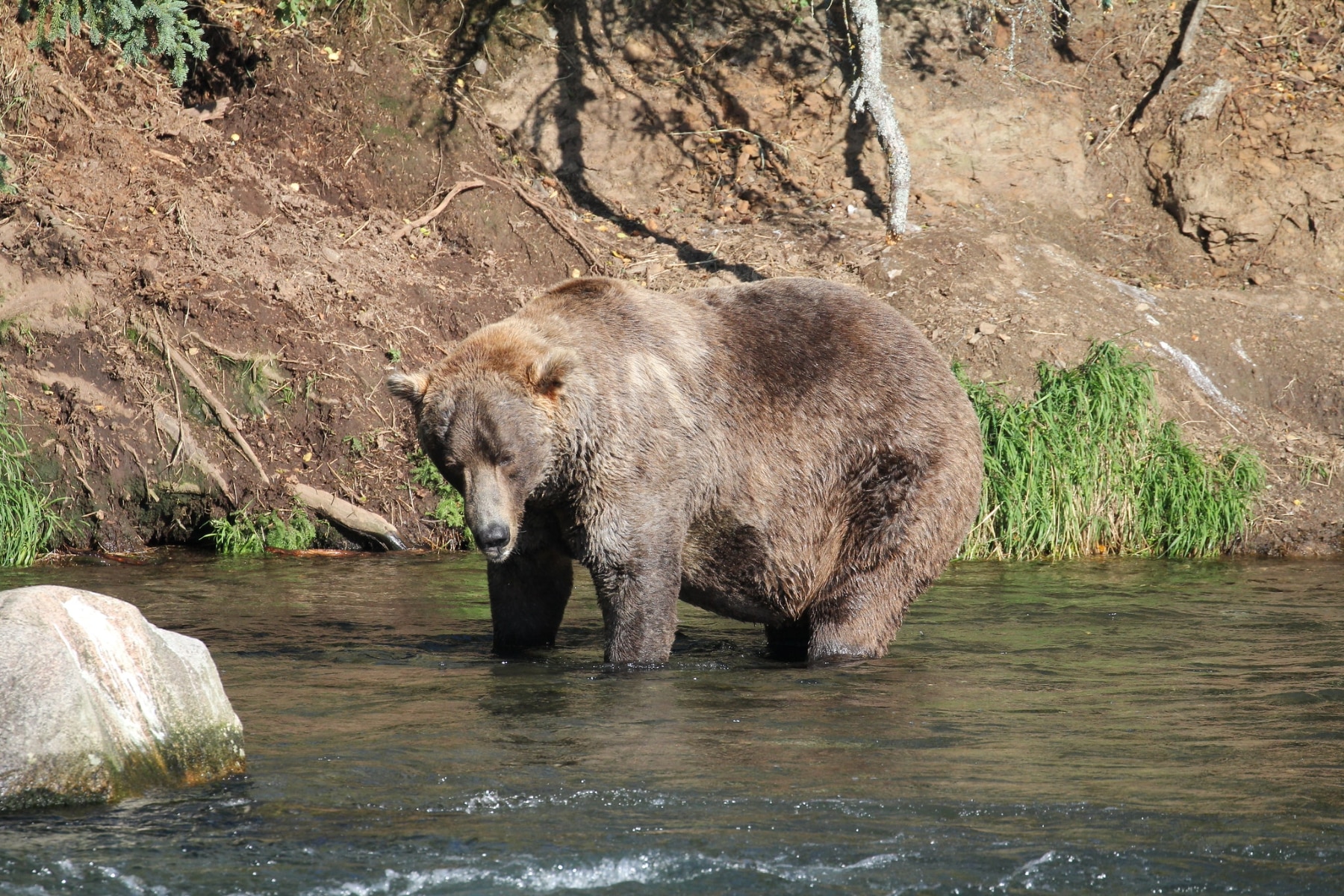
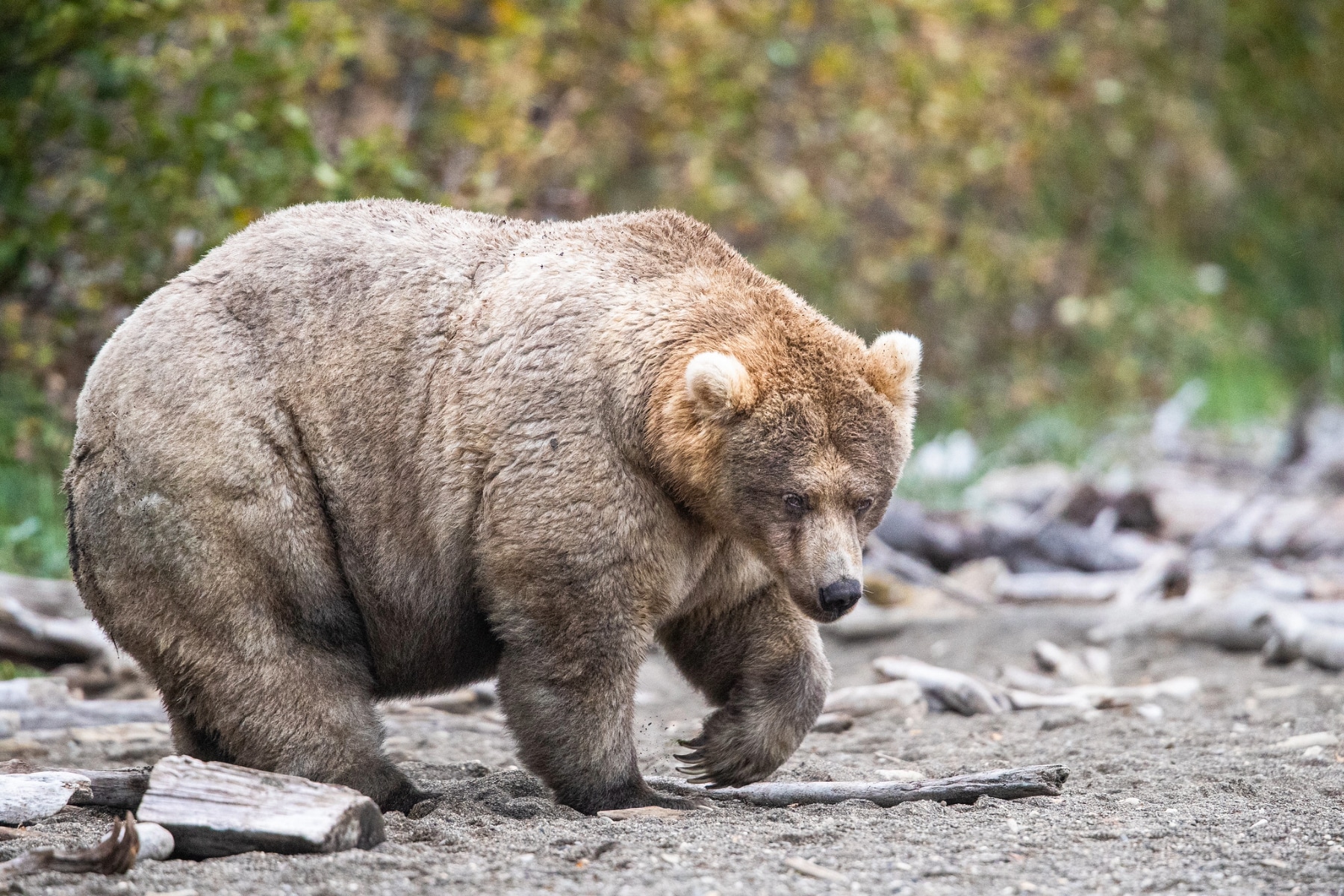

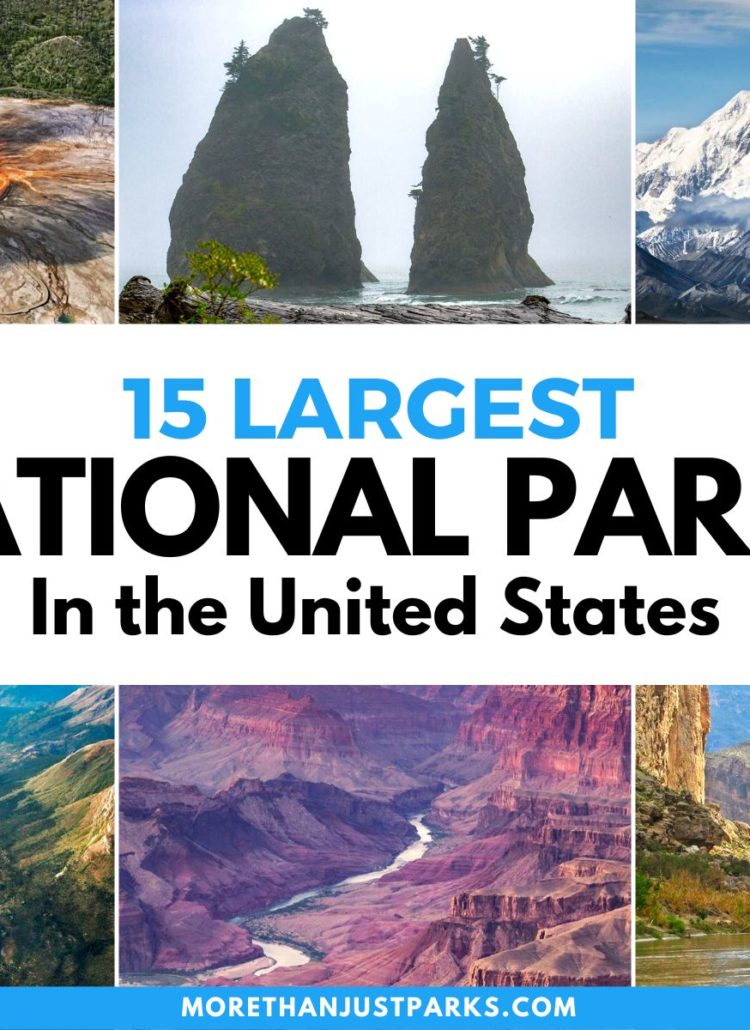
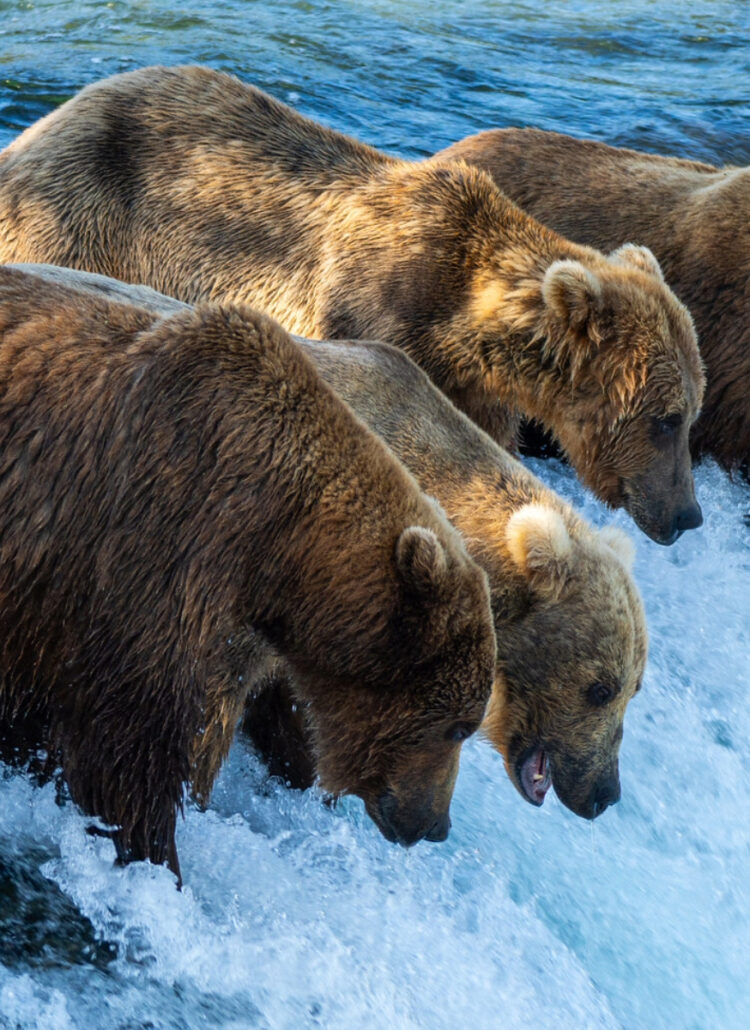


Leave a Reply